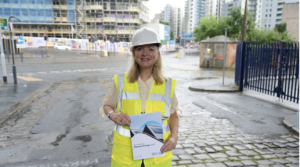Creating the right climate
Local authorities are expected to play a leading role in reducing the UK’s carbon footprint. New research suggests their primary challenge is to win communities over, as Michael Peters explains

Islington Council's 'energy doctors' go into communities to give personalised advice and talks on how to save money and cut carbon by saving energy.
Homes are responsible for approximately 27% of total CO2 emissions in the UK. Local action among householders driven by local government is increasingly seen as a key part of national efforts to curb carbon emissions.
According to policy papers, community members should increasingly be able to rely on their local authority ‘to coordinate, tailor and drive the development of a low carbon economy in their area’. New performance targets are being used to ensure local authorities are investing in low carbon programmes.
Several local authorities in the UK have been proactive in driving community engagement programmes and projects designed to connect their residents into processes of social change and more sustainable ways of living.
While some projects have been structured around the collective adoption of a new technology (for example, the installation of a renewable energy plant) others have focused more directly on education and support mechanisms to encourage improvement of energy management in and around the home.
So far, however, the perception is that local authorities, on the whole, have yet to achieve a substantial impact. The 2006 UK Climate Change Programme, for example, concluded local authority influence on the success of national carbon reduction policies was limited – with a key issue being the ability of authorities to engage with their communities.
WHAT WORKS?
Local government is ideally placed to be the lever towards creating low carbon communities for the future, through services, local knowledge and level of contact across networks of householders, businesses and community groups. The following looks at examples of local authority initiatives, what works, what doesn’t, and why.
Shropshire Council and Islington Council are examples of local authorities actively developing a range of projects that aim to engage their communities on a path to more sustainable environmental and energy-related futures under their emerging local strategic partnerships and climate change strategies.
A key element of Shropshire Council’s approach aims for significant reductions of CO2 emissions within three local communities, involving household residents and businesses as a pilot for measures which could be extended more widely.
The plan has included home energy checks, business and building audits, energy efficiency grants and ‘climate change months’ awareness-raising activities (which include climate change pub quizzes, film shows, cartoon competitions and interactive workshops).
Under its Green Living work, Islington Council created a community resource to help people in the borough reduce their carbon emissions in and around the home. The Green Living Centre provided face-to-face advice for visitors around four main areas: recycling, energy efficiency, biodiversity and green travel. The centre organised a programme of one-off events (e.g. plastic bag amnesties) to complement the drive to connect with the public, boost its profile and engender greater interest and increased visitor numbers.
A central aim of these schemes, according to the organisers who took part in research interviews, is the dissemination of educational messages on the growing urgency of climate change across the community, with the intention of instigating behaviour change. Alongside this aim is an emphasis on co-opting the cohesion and drive of already established social networks and community groups.
There was clearly an understanding – accompanying desire among the interviewees – to put the message across in a way which would resonate effectively with the differing needs and priorities of their community members. As this interviewee argued, for example: ‘You can engage people on climate change – you just have to do it in a particular way and over something that is relevant to individuals’ day-to-day lives… the style and type of communication is key.’
There was strong agreement regarding the opportunities which could be exploited through modification of existing services in the promotion of attitudinal and behaviour change. An emerging and growing body of evidence demonstrates that the relatively small number of best practice cases are in fact making some noteworthy progress that might usefully be replicated, with suitable modifications, on a broader scale.
KEY BARRIERS
The ability of local authorities to promote the effective dissemination of their informational campaigns can, however, be thwarted by apathy and indifference towards climate change among community members.
The experiences of participatory climate change projects in both Shropshire and Islington illustrate the difficulties associated with engaging larger numbers of community members. From the project management perspective it was suggested that this might simply be attributed in part to the hectic nature of modern life, where issues like climate change are low priority.
A central issue was felt to be the development of trust. For example, one of the interviewees argued that a project’s success is largely dependent upon participation, which in turn depends on how effectively the initiative is promoted and also the extent to which the target community believes and trusts in the organisation developing the project.
The existing perception and ‘image’ of local authorities and their role in the community was seen to be key. As one interviewee argued: ‘It can be quite difficult for local authorities. The local authority has an image. Most people wouldn’t dream of communicating with the local authority unless they had to.’
Whether provision of incentives for participation (for example, financial support towards insulation costs) constitutes a positive aspect of building a trust relationship with community members is not entirely clear. It does nevertheless provide a reason to participate additional to the anticipated environmental benefits that are central to this type of engagement programme.
Community-oriented action certainly has the potential to be a potent force for social change. What seems to be of crucial importance is the nature of how that prospective change is encouraged and facilitated. Approaches to engaging communities need practical and pragmatic elements to be built in from the outset; information-intensive interventions alone are unlikely to be effective.
Coordination of individual and collective behaviour change towards more sustainable patterns of living inevitably requires a policy mix that incorporates appropriate incentives and disincentives. Trust and knowledge are critical to changing behaviour. Appeals for making lifestyle changes to reduce carbon emissions must appear sufficiently relevant, worthwhile and feasible if they are to motivate community members to join in.
They need to tap into concerns about climate change that already exist and provide additional motivation, raising awareness of the contribution that a combined effort can make in realising reduced energy and carbon consumption.
- Michael Peters is senior research fellow at the Centre for Environmental Strategy, Surrey University. He co-edited Low Carbon Communities – Imaginative Approaches to Combating Climate Change Locally, which was published at the end of last year.















